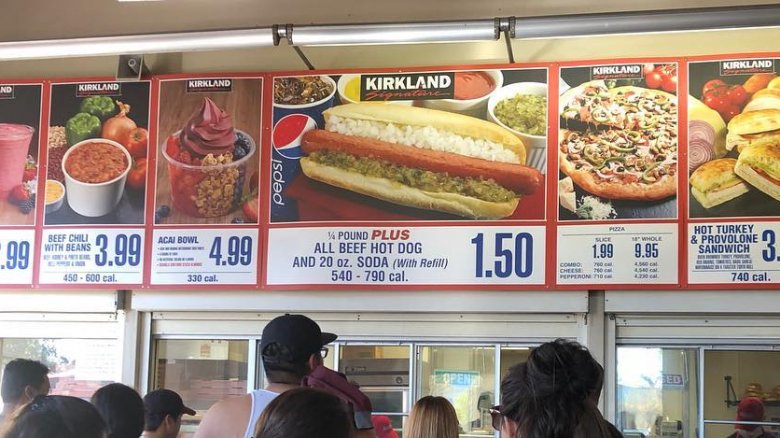This Is Why Costco's Hot Dog Combos Really Cost $1.50
Legions of Costco fans pony up their annual membership fee each year to take advantage of the bulk retailer's incredible deals on everything from 128-ounce jars of Hellmann's mayonnaise, to deeply discounted magnum bottles of surprisingly drinkable house brand champagne. But the true Costco fanatics know that a big part of the wholesale club giant's success comes a quarter pound at a time, and is served at the Costco food court: The legendary hot dog and 20 ounce soda combo, which clocks in at a wallet-pleasing $1.50.
It's one of the best bargains in quick-service food, but how did this ridiculously good deal get its start? It all began in 1984, when Hebrew National set up a cart outside of a Costco location in San Diego, in an attempt to lure in hungry customers, exhausted from hoisting 50-pound bags of dog food into their Costco shopping carts. The combo was an immediate success, and the price has remained unchanged for over 30 years, since 1985.
What drives ordinarily profit-hungry executives to keep the price for the hot dog and soda combo so impossibly low? After all, Costco actually loses money on every single combo sold, which adds up to around 135 million hot dogs per year. Tweaking prices, even a little, could dramatically impact the company's bottom line.
According 425Business, when Costco CEO W. Craig Jelenik complained about keeping a loss-leader like the hot dog combo on the menu to Costco co-founder Jim Sinegal, Sinegal made his opinion on the matter abundantly clear.
"I came to (Jim Sinegal) once and I said, 'Jim, we can't sell this hot dog for a buck fifty. We are losing our rear ends,'" Jelenik explained. "And he said, 'If you raise the effing hot dog, I will kill you. Figure it out.' That's all I really needed. By the way, if you raised (the price) to $1.75, it would not be that big of a deal. People would still buy (it). But it's the mindset that when you think of Costco, you think of the $1.50 hot dog (and soda)."
Why such an impassioned commitment to hot dog pricing? There are a few reasons. First, Costco is making a strategic choice to lose a few pennies on every hot dog combo sold, because it draws people into the store where they may be tempted to drop $1,400 on an outdoor patio set, or $2,500 on a riding lawn mower. A single customer who comes for the hot dogs but stays for the big screen television wipes out the loss on a few thousand hot dogs in just one transaction.
But there's another reason to keep prices low, and the food court humming with activity: A warm, family-friendly atmosphere creates excitement, and all of that action in the food court can be enough to lure in even more additional shoppers, as well as inspire existing customers to keep renewing their annual memberships.
Keeping the hot dog and soda combo at such a ridiculously low price hasn't always been easy, and has required some changes to product sourcing along the way. In 2013, Costco switched from serving Coca Cola products to Pepsi products, partly in an effort to keep costs low and maintain the hot dog combo's $1.50 price point. But there was an even more dramatic change even earlier, in 2009, when the company stopped serving Hebrew National brand all-beef kosher hot dogs, and instead established their own manufacturing facilities to produce the hot dogs in-house.
"What we figured out we could do is build our own hot dog-manufacturing plant (in Los Angeles) and make our own Kirkland Signature hot dogs," explained Jelenik. "Now we are doing so much hot dog business that we've opened up another plant in Chicago.
Though the change sent shock waves rippling through Costco food courts nationwide, the change not only helped keep the price at $1.50, but ultimately may have resulted in an even better product. According to Costco, the house-manufactured Kirkland brand hot dogs now served at every food court are "10 percent heavier and longer than the old," and they're a better quality hot dog.
"By having the discipline to say, 'You are not going to be able to raise your price. You have to figure it out,' we took it over and started manufacturing our hot dogs. We keep it at $1.50 and make enough money to get a fair return."
In the 2009 edition of Costco Connection, David Fuller, the assistant vice president of publishing, clarified the rationale for keeping the combo priced at $1.50 even further. He says that Costco was committed to showing that "a business can operate on a fair markup and still pay all of its bills."
"Holding a price that steady for that long sends a clear message about what is possible when you decide to operate your business model on a 'cost plus' basis instead of a 'what the market will bear' basis," Fuller wrote.
In spite of technically losing money on every hot dog sold, the $1.50 combo is probably here to stay. It keeps customers coming back again and again, and indirectly translates to big business for the retail giant. We think journalist Eric Schaefer summed up the deal best, in his article for the Phoenix Sun Times: "What's more American than buying 24 rolls of toilet paper, 64 ounces of mayonnaise, a case of beer, a few racks of ribs from the butcher, and throwing down a hot dog on the way out? Simply put: nothing. And as a bonus, you can also buy enough antacid to last a lifetime."
